Mitotic cell cycle Study guides, Class notes & Summaries
Looking for the best study guides, study notes and summaries about Mitotic cell cycle? On this page you'll find 997 study documents about Mitotic cell cycle.
All 997 results
Sort by
 Popular
Popular
-
Edexcel as level biology question paper 2 ju ne 2023 salters Nuffield + mark scheme
- Exam (elaborations) • 52 pages • 2024
-
- $9.49
- 5x sold
- + learn more
Please check the examination details below before entering your candidate information Candidate surname Other names Centre Number Candidate Number Pearson Edexcel Level 3 GCE Thursday 25 May 2023 Morning (Time: 1 hour 30 minutes) Paper reference 8BN0/02 Total Marks Biology A (Salters Nuffield) Advanced Subsidiary PAPER 2: Development, Plants and the Environment You must have: Calculator, HB pencil, ruler Instructions • Use black ink or ball-point pen. • Fill in the boxes at the...
 Popular
Popular
-
Test Bank Porth Pathophysiology Concepts of Altered Health States 2nd Canadian Edition
- Exam (elaborations) • 289 pages • 2023 Popular
-
- $17.99
- 4x sold
- + learn more
Test Bank Porth Pathophysiology Concepts of Altered Health States 2nd Canadian EditionTable of Contents Chapter 01: Concepts of Health and Disease .......................................................................................................... 2 Chapter 02: Concepts of Altered Health in Children ............................................................................................. 13 Chapter 03: Concepts of Altered Health in Older Adults ............................................
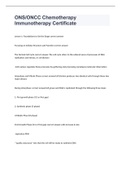
-
ONS/ONCC Chemotherapy Immunotherapy Certificate exam 2022/2023 with 100% correct answers
- Exam (elaborations) • 28 pages • 2022
-
Available in package deal
-
- $11.49
- 19x sold
- + learn more
Lesson 1: Foundations to Set the Stage ... Focusing on Cellular Structure and Function ... The Normal Cell Cycle -The cell cycle refers to the ordered seres of processes of DNA replication and mitosis, or cell division -Cell nucleus regulates these processes by gathering and processing complexes molecular information Interphase and Mitotic Phase Cell division produces two identical cells through these two major phases During interphase: Cell grows and DNA is r...
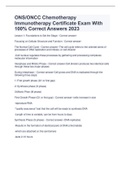
-
ONS/ONCC Chemotherapy Immunotherapy Certificate Exam With 100% Correct Answers 2023
- Exam (elaborations) • 20 pages • 2023
-
Available in package deal
-
- $17.99
- 4x sold
- + learn more
Lesson 1: Foundations to Set the Stage - Correct answerFocusing on Cellular Structure and Function - Correct answerThe Normal Cell Cycle - Correct answer--The cell cycle refers to the ordered seres of processes of DNA replication and mitosis, or cell division -Cell nucleus regulates these processes by gathering and processing complexes molecular information Interphase and Mitotic Phase - Correct answer-Cell division produces two identical cells through these two major phases During interph...
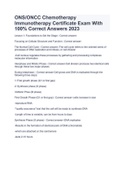
-
ONS/ONCC Chemotherapy Immunotherapy Certificate Exam With 100% Correct Answers 2023.
- Exam (elaborations) • 20 pages • 2023
- Available in package deal
-
- $12.49
- 1x sold
- + learn more
ONS/ONCC Chemotherapy Immunotherapy Certificate Exam With 100% Correct Answers 2023. Lesson 1: Foundations to Set the Stage - Correct answerFocusing on Cellular Structure and Function - Correct answerThe Normal Cell Cycle - Correct answer--The cell cycle refers to the ordered seres of processes of DNA replication and mitosis, or cell division -Cell nucleus regulates these processes by gathering and processing complexes molecular information Interphase and Mitotic Phase - Correct answer-Cel...
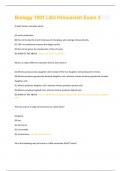
-
Biology 1001 LSU Hrincevich Exam 3 Questions With 100% Correct Answers.
- Exam (elaborations) • 12 pages • 2023
- Available in package deal
-
- $8.49
- 1x sold
- + learn more
Growth factors stimulate what? (A) cyclin production. (B) the cell to skip the S and G1 phases of interphase and undergo mitosis directly. (C) Cdk's to synthesize enzymes that digest cyclins. (D) the cell to ignore the checkpoints of the cell cycle. (E) NONE OF THE ABOVE - Answer (A) cyclin production What is a major difference between mitosis and meiosis? (A) Meiosis produces two daughter cells instead of the four daughter cells produced in mitosis. (B) Meiosis produces genetically ide...

-
APHON Principles of Chemo and Biotherapy, Top Questions and answers, 100% Accurate. Verified.
- Exam (elaborations) • 6 pages • 2023
-
Available in package deal
-
- $9.49
- 2x sold
- + learn more
APHON Principles of Chemo and Biotherapy, Top Questions and answers, 100% Accurate. Verified. Biotherapy - Targeted anticancer agents also known as biological response modifiers (BRM) Tyrosine kinase inhibitors (TKIs) are what class - Biotherapy Monoclonal antibodies (MoAbs) are what class - Biotherapy Define pharmacokinetics - Study of drug absorption, metabolism, and excretion Define pharmacodynamics - The concentration of the drug in the body and how it produces a response ...
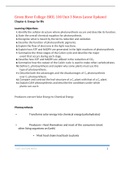
-
Green River College: BIOL 100 Unit 3 Notes Latest Updated,100% CORRECT
- Class notes • 116 pages • 2023
-
- $16.99
- 1x sold
- + learn more
Green River College: BIOL 100 Unit 3 Notes Latest Updated Chapter 6: Energy for life Learning Objectives: 1. Identify the cellular structure where photosynthesis occurs and describe its function. 2. State the overall chemical equation for photosynthesis. 3. Recognize what is meant by the terms reduction and oxidation. 4. Describe the function of photosynthetic pigments. 5. Explain the flow of electrons in the light reactions. 6. Explain how ATP and NADPH are generated in the light reac...
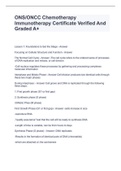
-
ONS/ONCC Chemotherapy Immunotherapy Certificate Verified And Graded A+
- Exam (elaborations) • 20 pages • 2022
-
Available in package deal
-
- $14.99
- 2x sold
- + learn more
Lesson 1: Foundations to Set the Stage ... Focusing on Cellular Structure and Function ... 00:26 01:17 The Normal Cell Cycle -The cell cycle refers to the ordered seres of processes of DNA replication and mitosis, or cell division -Cell nucleus regulates these processes by gathering and processing complexes molecular information Interphase and Mitotic Phase Cell division produces two identical cells through these two major phases During interphase: Cell grows ...

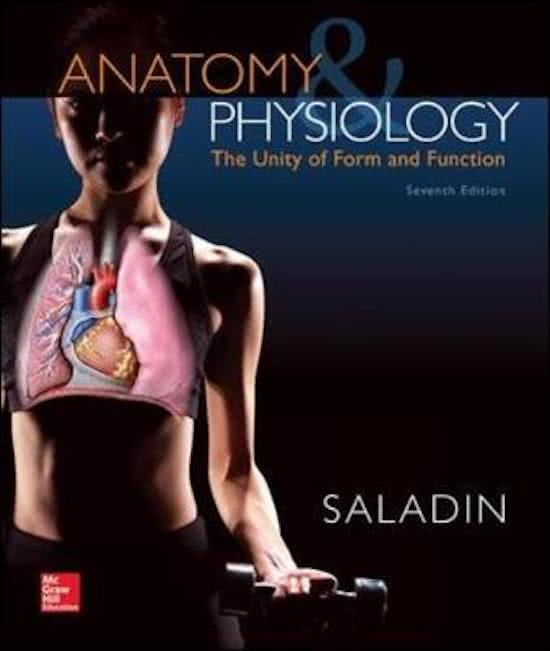
-
Test Bank For Anatomy & Physiology The Unity Of FormAnd Function 7th Edition by Kenneth S. Saladin
- Exam (elaborations) • 741 pages • 2023
-
Available in package deal
-
- $20.16
- 1x sold
- + learn more
Chapter 04 Genetics of Cellular Function Answer Key True / False Questions 1. Naked DNA is called chromatin. FALSE Accessibility: Keyboard Navigation Blooms Level: 1. Remember Gradable: automatic HAPS Objective: C12.04 Analyze the interrelationships among chromatin, chromosomes and chromatids. HAPS Topic: Module C12 Somatic cell division. Learning Outcome: 04.01b Explain how DNA and proteins are organized to form the chromosomes. Section: 04.01 Topic: Nucleic acids: DNA and RNA 2. DNA is ...
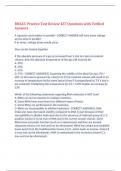
-
RNAS C Practice Test Review 437 Questions with Verified Answers,100% CORRECT
- Exam (elaborations) • 128 pages • 2024
-
- $13.49
- 1x sold
- + learn more
RNAS C Practice Test Review 437 Questions with Verified Answers A capacitor and resisitor in parallel - CORRECT ANSWER will have same voltage across since in parallel. if in series, voltage drops would occur they can be treated together If the absolute pressure of a gas is increased from 3 atm to 4 atm at constant volume, then the absolute temperature of the gas will increase by: A. 25%. B. 33%. C. 67%. D. 75% - CORRECT ANSWER B. Assuming the validity of the Ideal-Gas law, PV = n...

Study stress? For sellers on Stuvia, these are actually golden times. KA-CHING! Earn from your study resources too and start uploading now. Discover all about earning on Stuvia


